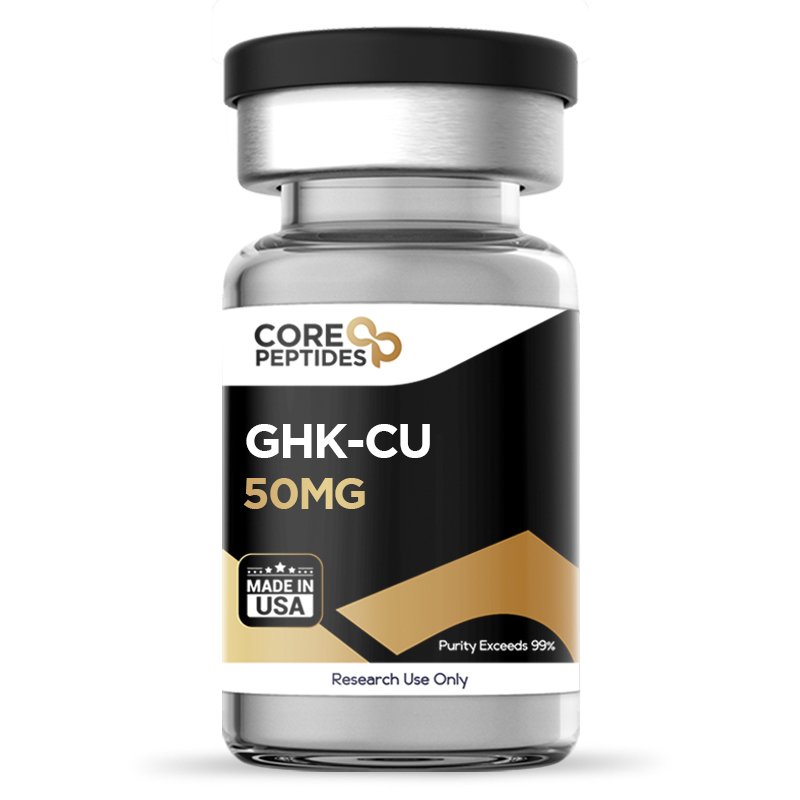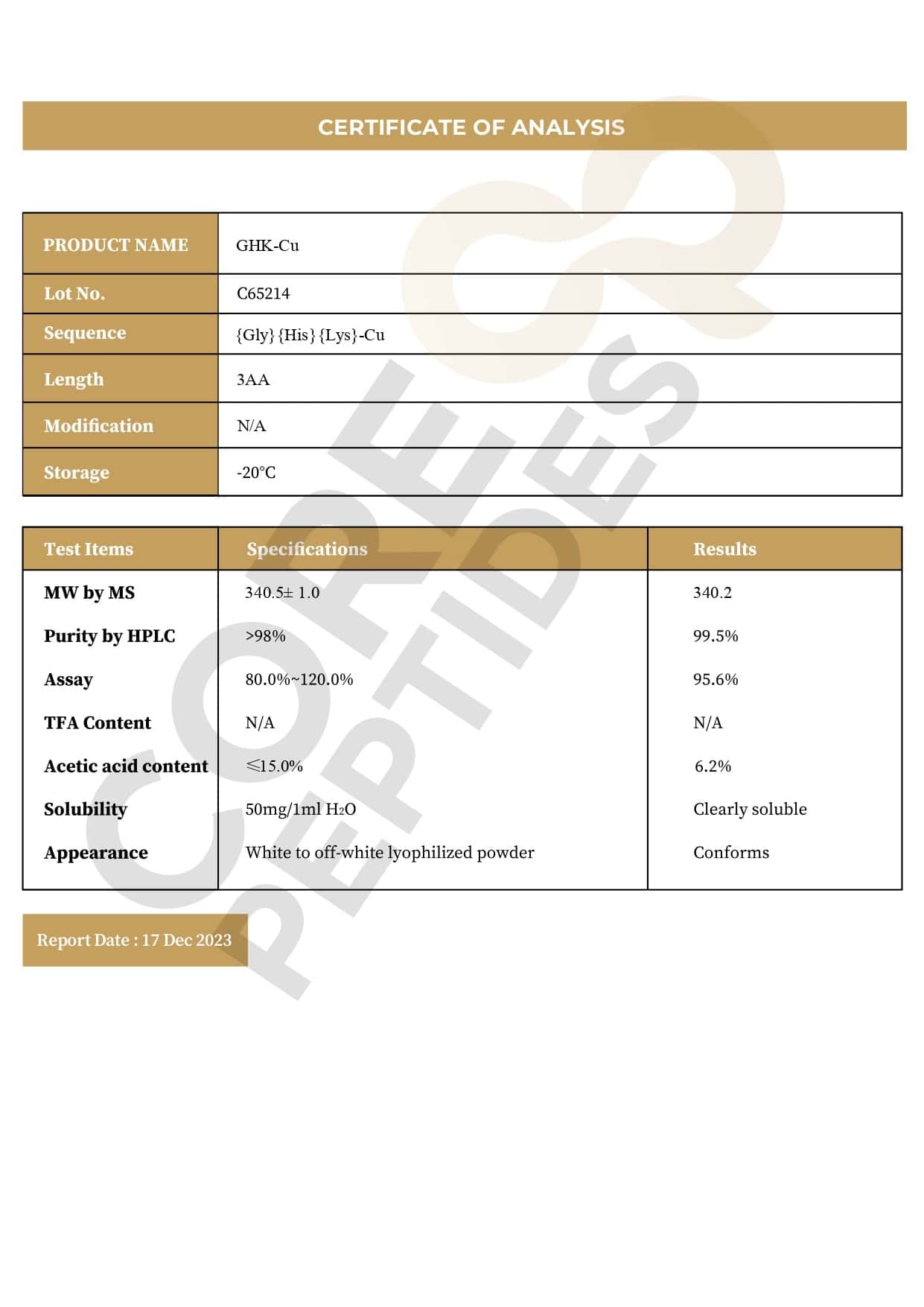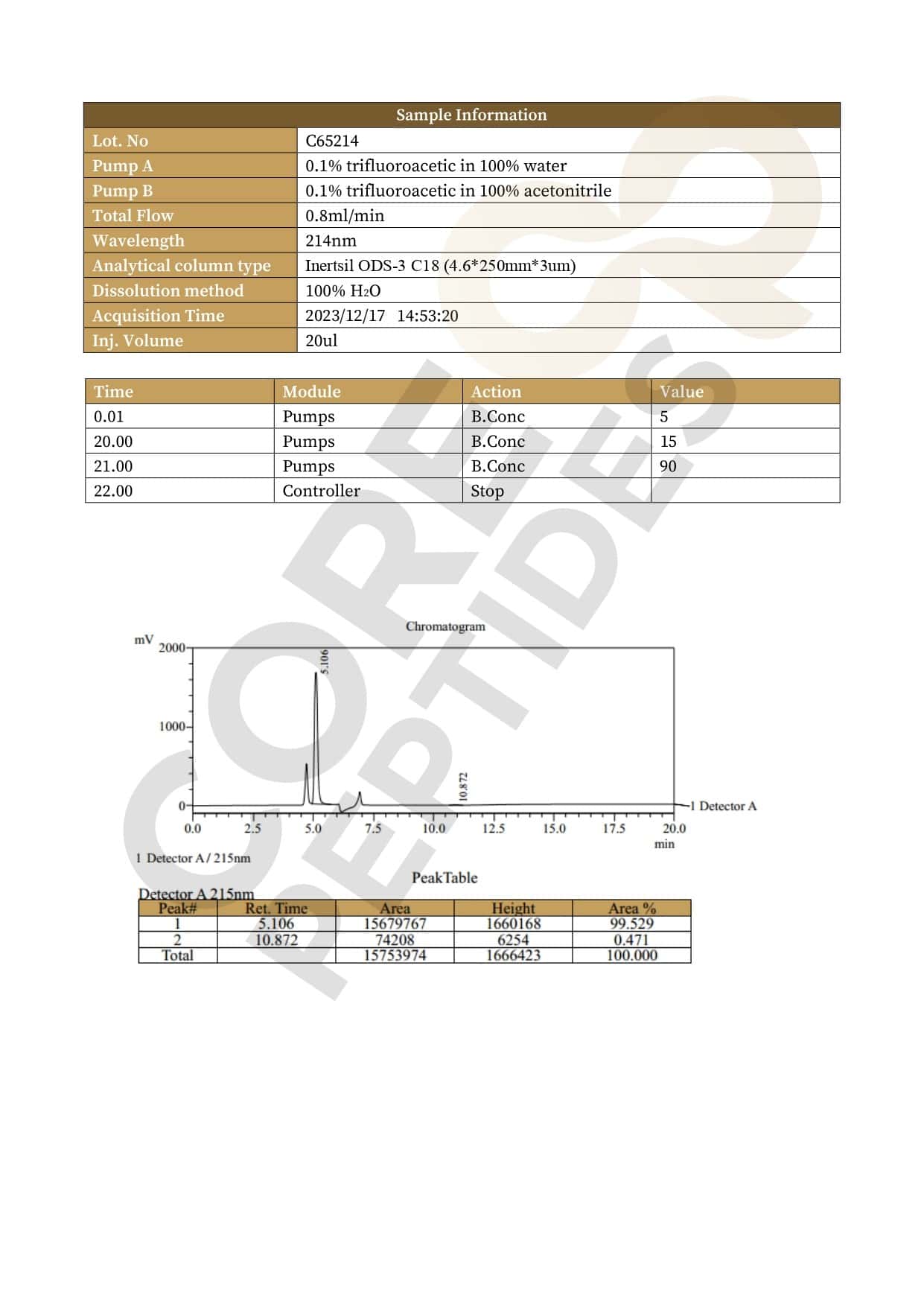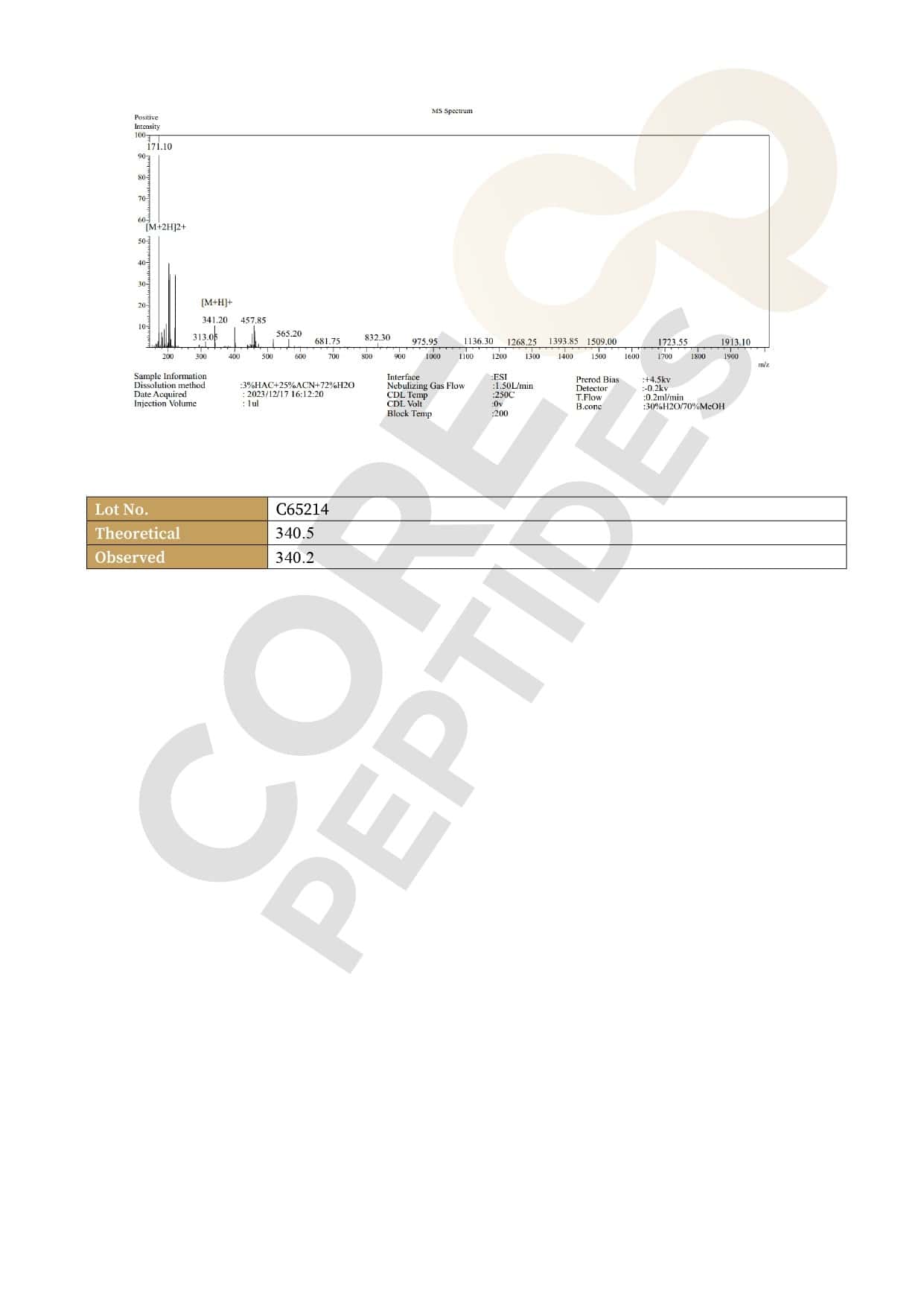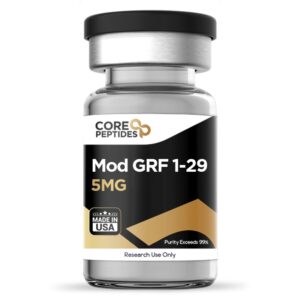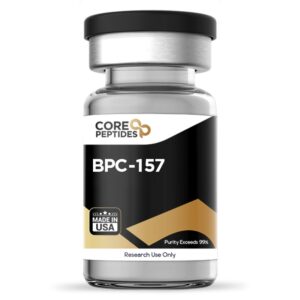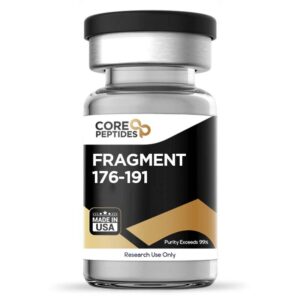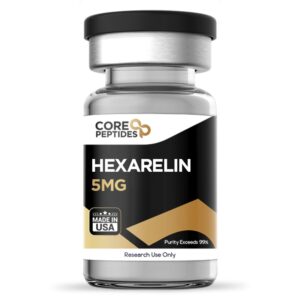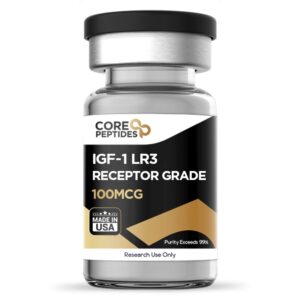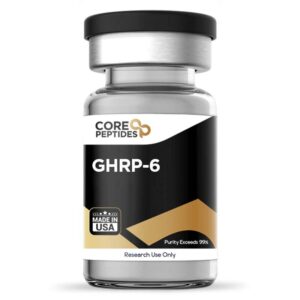GHK-Cu (Copper) (50mg)
Original price was: $68.00.$55.00Current price is: $55.00.
Size: 50mg
Contents: GHK-Cu (50mg)
Form: Lyophilized powder
Purity: >99%
SKU: P-GHKCU-50
FREE Shipping on $200+ orders
FREE Bacteriostatic Water (30ml) on $200+ orders
Discount per Quantity
| Quantity | Discount | Price |
|---|---|---|
| 5 - 8 | 5% | $52.25 |
| 9 + | 10% | $49.50 |
GHK-Cu (Copper) Peptide
GHK-Cu is a naturally occurring copper-binding peptide composed of 3 amino acids, i.e. glycyl-L-histidyl-L-lysine.(1) -Cu refers to the chemical addition of copper. GHK-Cu (Copper) is a small tripeptide found in plasma and reportedly releases at the time of injury. The concentration of GHK-Cu declines with age. At 20 years, the average concentration of GHK-Cu of 200 ng/mL declines to 80 ng/mL by 60 years.(1)
Studies(4) have suggested when the plasma GHK peptide is added to the cell culture in nanomolar amounts; the peptide has the potential to induce a wide range of responses from growth stimulation to toxic cell differentiation. During the isolation of the peptide, researchers suggested that it exhibited potential chelating properties and might co-isolate with almost the same amount of copper ions and a fifth of the amount of iron found in the cells. When the peptide was incubated in the isolated cells as a bound complex with copper and iron molecules, maximal potential was reported.
Overview
Studies(5) have suggested that the peptide exhibits potential in gene expression and may to reset elements of the genome. By this potential mechanism, GHK-Cu peptide may restore impaired cells, including carcinogenic cells and COPD cells. GHK-Cu peptide has been researched for its potential across a variety of functions(1) including that it may tighten and reverse the thinning of aging skin structure, supporting the extracellular matrix, that it may restore the skin barrier and moderate texture, hyperpigmentation and lesions, may support tissue repair and mitigate inflammation, may stimulate increasing hair follicle size, may exert antioxidant properties and, finally, may exhibit gene restructuring potential.
Specifications
Molecular Formula: C14H24N6O4
Molecular Weight: 340.38 g/mol
Other Known Titles: glycyl-L-histidyl-L-lysine-copper 2+
Research and Clinical Studies
GHK Peptide Initial Research
This 1980s study(6) suggested the biological potential of the naturally occurring peptide in tissue repair. GHK peptide may host copper (II) ions due to possible copper affinity and may thereby stimulate the synthesis of collagen and increase the accumulation of total proteins and DNA at the injury site. Dermal wounded rats were used for this study. At the time of injury, the release of GHK peptide was induced. ‘Emergency response molecules’ were released from the matrix at the site of injury. Once released, GHK appeared to bind with Cu ions found in the blood and then stimulate the synthesis of decorin protein. Decorin protein is responsible for the synthesis of collagen and regulation of wound healing and anti-tumor defense mechanism. Further studies in the 2000s,(7) suggested that the GHK-Cu peptide hosts the potential to not only stimulate the collagen synthesis but also stimulate the production of tissue inhibitors, TIMP-1 and TIMP-2.
GHK Peptide and Tissue Repair
In this study,(8) the main aim was to understand the action of the GHK-Cu peptide complex when applied to the open wounds in comparison to zinc oxide. 18 New Zealand white rabbits were used for this study, divided into three groups – one group was presented with GHK-Cu, second group with zinc oxide and third group with placebo. Woulds were induced on each rabbit and the rabbits were presented with the respective compounds for 21 consecutive days. After 21 days, it was suggested by the researchers that the group delivered with the GHK-Cu peptide complex appeared to exhibit increased healing compared to the group given zinc oxide or placebo.
In this study,(9) the main aim was to understand the action of the GHK-Cu peptide complex as compared to helium neon laser. Laser applications were measured at 1 J cm2 and 3 J cm2. 24 New Zealand white rabbits were used for this study, divided into three groups and presented with respective concentrations of the GHK-Cu peptide complex and helium neon laser application. Experimental wounds were created on all the rabbits and all rabbits were studied for 28 consecutive days with the respective compounds. After the study, it was suggested by the researchers that rabbits studied with GHK-Cu peptide and higher concentration of the laser application appeared more receptive toward wound healing than the other group. The rabbits presented with GHK-Cu peptide exhibited an apparent decline in neutrophil counts and increase in neovascularization.
GHK Peptide and Metastasis
In this 1983 study,(1) the actions of the mixture of GHK-Cu complex and ascorbic acid (Vitamin C) on the growth of the sarcoma (tumor) cells was observed. 180 mice with cancerous growths were exposed to this mixture. Researchers suggested the mixture had the potential to induce a decline in the growth of carcinogenic cells in the subject mice. It was later reported by the researchers that GHK-Cu peptide complex exhibited some potential in increasing the expression of caspase and the associated genes, as well as gene expression associated with DNA repair. Specifically, this peptide seemed to suppress the growth of two types of cancer cells in experimental settings: SH-SY5Y neuroblastoma cells, which are a model for studying nerve cell behavior and pathology, and U937 histiocytic lymphoma cells, which are used to study the immune system's response to cancer. Additionally, the peptide might have reactivated the apoptosis pathway, a type of programmed cell death crucial for removing faulty cells, as evidenced by activity in caspases 3 and 7, which are enzymes that play key roles in apoptosis. Conversely, in a study of non-cancerous cells, GHK appeared to promote the growth of NIH-3T3 fibroblasts, which are healthy cells often used as a standard model to examine cell division and growth.
GHK Peptide and Ulcers
This clinical study(10) was carried out in diabetic subjects with neuropathic ulcers. All subjects were enrolled in a standard wound care protocol, where only the subjects with sharp ulcer wound or debridement were entered into this randomized, placebo controlled clinical trial. The study was carried out using GHK-Cu peptide complex gel. All subjects were divided into different groups, where one group was presented with the peptide gel, whereas others were given standard care with a placebo application. Following the study, researchers suggested that the subjects given the gel exhibited apparently elevated healing at 98%+. The gel complex appeared to have the potential to induce closure of 98.5% of plantar ulcers whereas the control only reportedly induced 60.8% of ulcer healing.
GHK Peptide and Behavioral Properties
In this study,(1) GHK-Cu was delivered to mice to measure pain mitigation. Mice were placed on a moderately hot plate. Due to heat and the pain, it would usually take longer for mice to lick their paws; however, upon delivery the peptide, the time taken to lick their paws reduced compared to control environments. Researchers suggested the mice got ‘comfortable’ and their pain was eased faster with the presence of GHK-Cu.
In this study,(11) male rats were deposited into a maze, which was intended to induce anxiety and cause behavioral changes. If anxious, rats were observed to restrict arm movement, keeping "close arms"; whereas "open arm" behavior was shown in rats with lessened levels of anxiety. As a part of the study, once the peptide was delivered, the time spent by the rats in "open arms" state in the maze was monitored. After the study, it was reported by the researchers that the peptide exhibited some potential in increasing "open arms" states in the subjects.
In an additional study,(12) two rats were placed in a small cage and were then given minor electric shocks. As a result of these shocks, the rat would become agitated and attack the second rat. Twelve minutes before this experiment, GHK-Cu peptide was delivered to both rats. It was noted by the researchers that the number of attacks, after the electric shocks, reduced by 5 times than usual.
GHK-Cu and Antioxidative potential
A study has investigated the potential of Glycyl-L-histidyl-L-lysine (GHK) to regulate the presence of reactive oxygen species (ROS) within laboratory cells, with a focus on its ability to mitigate oxidative stress through interactions with various ROS types.(13) GHK is proposed to act as an endogenous antioxidant, potentially due to its selective targeting and neutralization of certain radicals, specifically hydroxyl (·OH) and peroxyl (ROO·) radicals. The antioxidant properties of GHK were assessed using two primary techniques: flow cytometry, a method for analyzing various cellular characteristics, and electron spin resonance (ESR) spin-trapping, which is employed to detect free radicals. Throughout these evaluations, GHK appeared to lower ROS levels induced by tert-butyl hydroperoxide (t-BOPD), a chemical known to promote oxidative stress within cells. The ESR data revealed that GHK was notably positive in reducing the concentrations of ·OH and ROO· radicals, although it had a seemingly modest action on superoxide (O2 -·) radicals. Additional examinations utilizing ESR assessed the relative potential of GHK in neutralizing ·OH radicals compared to other antioxidants like carnosine and reduced glutathione (GSH), both recognized for their antioxidant capabilities. Preliminary results suggest that GHK could be more proficient at neutralizing ·OH radicals compared to these alternatives.
GHK-Cu and Antioxidative potential
A study has investigated the possible mechanisms through which the peptide complex GHK-Cu could influence anti-inflammatory actions, particularly against lung tissue inflammation induced by cigarette smoke (CS).(14) It is hypothesized that GHK-Cu may influence various biochemical pathways and molecular markers related to inflammation and oxidative stress, although the specific mechanisms remain somewhat uncertain. In experiments involving mouse models exposed to CS, exposure to GHK-Cu was linked to a potential decrease in the production of pro-inflammatory cytokines, including interleukin-1β (IL-1β) and tumor necrosis factor-α (TNF-α), found in bronchoalveolar lavage fluid—fluid used to capture cells and soluble factors from the airways and lung tissues. These results tentatively suggest that GHK-Cu might help mitigate the inflammatory responses triggered by cigarette smoke. Additionally, there was a noted possible reduction in the activity of myeloperoxidase (MPO), an enzyme that serves as a marker for neutrophil-driven inflammation and oxidative stress, in lung tissues that received GHK-Cu exposure. This observation could indicate a potential role of GHK-Cu in limiting the activation or mobilization of neutrophils, possibly curtailing the oxidative bursts and consequent inflammation. At the molecular level, the research proposes that GHK-Cu may interact with the nuclear factor kappa-light-chain-enhancer of activated B cells (NF-κB) signaling pathway. NF-κB plays a critical role in the initiation and perpetuation of inflammation. The peptide complex is thought to possibly inhibit NF-κB activation by affecting the phosphorylation of IκBα, a protein that inhibits NF-κB. This interaction could hypothetically result in lower expression of genes that promote inflammation, controlled by NF-κB. Furthermore, the study suggests that GHK-Cu could potentially influence the nuclear factor erythroid 2-related factor 2 (Nrf2) pathway. Nrf2 is integral to cellular defenses against oxidative damage. GHK-Cu is posited to possibly boost the expression and nuclear translocation of Nrf2 in lung tissues, thereby promoting the transcription of genes that combat oxidative stress and possibly enhancing the cellular resilience against oxidative damage. The investigation further examines how GHK-Cu interacts with markers of oxidative stress, such as malondialdehyde (MDA) and glutathione (GSH). MDA is a product of lipid peroxidation and an indicator of oxidative stress, while GSH is a vital antioxidant that plays a crucial role in cellular defense mechanisms. The experimentation with GHK-Cu is associated with a tentative reduction in MDA levels and a possible restoration of GSH levels, suggesting a potential ameliorative action on oxidative stress.
GHK-Cu and Lipid Peroxidation
A theoretical model posits that GHK could play a role in mitigating the discharge of iron from ferritin.(15) Ferritin, a protein complex that stores iron, releases it in a form that can facilitate lipid peroxidation, a process where free radicals attack lipids, leading to cell damage. It is suggested that GHK might inhibit the assembly of iron complexes within injured tissues, which could, in turn, decrease inflammation. Further exploration of GHK's role reveals that it may interact with specific biological pathways that govern the release of iron from ferritin. This interaction might restrict the release of iron by up to 87%, although this is a provisional estimate. Such a significant reduction in iron release could conceivably diminish both inflammation and oxidative stress, the latter being a condition where damaging oxidative processes occur more rapidly than the body's ability to counteract them, in the affected tissues.
GHK-Cu peptide is available for research and laboratory purposes only. Please review and adhere to our Terms and Conditions before ordering.
References:
- Pickart, Loren, and Anna Margolina. “Regenerative and Protective Actions of the GHK-Cu Peptide in the Light of the New Gene Data.” International journal of molecular sciences vol. 19,7 1987. 7 Jul. 2018, doi:10.3390/ijms19071987. https://www.ncbi.nlm.nih.gov/pmc/articles/PMC6073405/
- Pickart L, Freedman JH, Loker WJ, Peisach J, Perkins CM, Stenkamp RE, Weinstein B. Growth-modulating plasma tripeptide may function by facilitating copper uptake into cells. Nature. 1980 Dec 25;288(5792):715-7. doi: 10.1038/288715a0. PMID: 7453802. https://pubmed.ncbi.nlm.nih.gov/7453802/
- L.O. Pilgeram, L.R. Pickart, Control of fibrinogen biosynthesis: The role of free fatty acid, Journal of Atherosclerosis Research, Volume 8, Issue 1, 1968, Pages 155-166, ISSN 0368-1319, https://doi.org/10.1016/S0368-1319(68)80089-4
- Pickart L, Freedman JH, Loker WJ, Peisach J, Perkins CM, Stenkamp RE, Weinstein B. Growth-modulating plasma tripeptide may function by facilitating copper uptake into cells. Nature. 1980 Dec 25;288(5792):715-7. doi: 10.1038/288715a0. PMID: 7453802. https://pubmed.ncbi.nlm.nih.gov/7453802/
- Pickart L, Vasquez-Soltero JM, Margolina A. GHK and DNA: resetting the human genome to health. Biomed Res Int. 2014;2014:151479. doi: 10.1155/2014/151479. Epub 2014 Sep 11. PMID: 25302294; PMCID: PMC4180391. https://pubmed.ncbi.nlm.nih.gov/25302294/
- Maquart FX, Pickart L, Laurent M, Gillery P, Monboisse JC, Borel JP. Stimulation of collagen synthesis in fibroblast cultures by the tripeptide-copper complex glycyl-L-histidyl-L-lysine-Cu2+. FEBS Lett. 1988 Oct 10;238(2):343-6. doi: 10.1016/0014-5793(88)80509-x. PMID: 3169264. https://pubmed.ncbi.nlm.nih.gov/3169264/
- Siméon A, Emonard H, Hornebeck W, Maquart FX. The tripeptide-copper complex glycyl-L-histidyl-L-lysine-Cu2+ stimulates matrix metalloproteinase-2 expression by fibroblast cultures. Life Sci. 2000 Sep 22;67(18):2257-65. doi: 10.1016/s0024-3205(00)00803-1. PMID: 11045606. https://pubmed.ncbi.nlm.nih.gov/11045606/
- Cangul IT, Gul NY, Topal A, Yilmaz R. Evaluation of the effects of tripeptide-copper complex and zinc oxide on open-wound healing in rabbits. Vet Dermatol. 2006 Dec;17(6):417-23. doi: 10.1111/j.1365-3164.2006.00551.x. PMID: 17083573. https://pubmed.ncbi.nlm.nih.gov/17083573/
- Gul NY, Topal A, Cangul IT, Yanik K. The effects of tripeptide copper complex and helium-neon laser on wound healing in rabbits. Vet Dermatol. 2008 Feb;19(1):7-14. doi: 10.1111/j.1365-3164.2007.00647.x. PMID: 18177285. https://pubmed.ncbi.nlm.nih.gov/18177285/
- Mulder GD, Patt LM, Sanders L, Rosenstock J, Altman MI, Hanley ME, Duncan GW. Enhanced healing of ulcers in patients with diabetes by treatment with glycyl-l-histidyl-l-lysine copper. Wound Repair Regen. 1994 Oct;2(4):259-69. doi: 10.1046/j.1524-475X.1994.20406.x. PMID: 17147644. https://pubmed.ncbi.nlm.nih.gov/17147644/
- Bobyntsev II, Chernysheva OI, Dolgintsev ME, Smakhtin MY, Belykh AE. Anxiolytic effects of Gly-His-Lys peptide and its analogs. Bull Exp Biol Med. 2015 Apr;158(6):726-8. doi: 10.1007/s10517-015-2847-3. Epub 2015 Apr 23. PMID: 25900608. https://pubmed.ncbi.nlm.nih.gov/25900608/
- Sever'yanova LА, Dolgintsev ME. Effects of Tripeptide Gly-His-Lys in Pain-Induced Aggressive-Defensive Behavior in Rats. Bull Exp Biol Med. 2017 Dec;164(2):140-143. doi: 10.1007/s10517-017-3943-3. Epub 2017 Nov 27. PMID: 29181666. https://pubmed.ncbi.nlm.nih.gov/29181666/
- Sakuma, S., Ishimura, M., Yuba, Y., Itoh, Y., & Fujimoto, Y. (2018). The peptide glycyl-ʟ-histidyl-ʟ-lysine is an endogenous antioxidant in living organisms, possibly by diminishing hydroxyl and peroxyl radicals. International journal of physiology, pathophysiology and pharmacology, 10(3), 132–138.
- Zhang, Q., Yan, L., Lu, J., & Zhou, X. (2022). Glycyl-L-histidyl-L-lysine-Cu2+ attenuates cigarette smoke-induced pulmonary emphysema and inflammation by reducing oxidative stress pathway. Frontiers in molecular biosciences, 9, 925700. https://doi.org/10.3389/fmolb.2022.925700
- Miller, D. M., DeSilva, D., Pickart, L., & Aust, S. D. (1990). Effects of glycyl-histidyl-lysyl chelated Cu(II) on ferritin dependent lipid peroxidation. Advances in experimental medicine and biology, 264, 79–84. https://doi.org/10.1007/978-1-4684-5730-8_11

